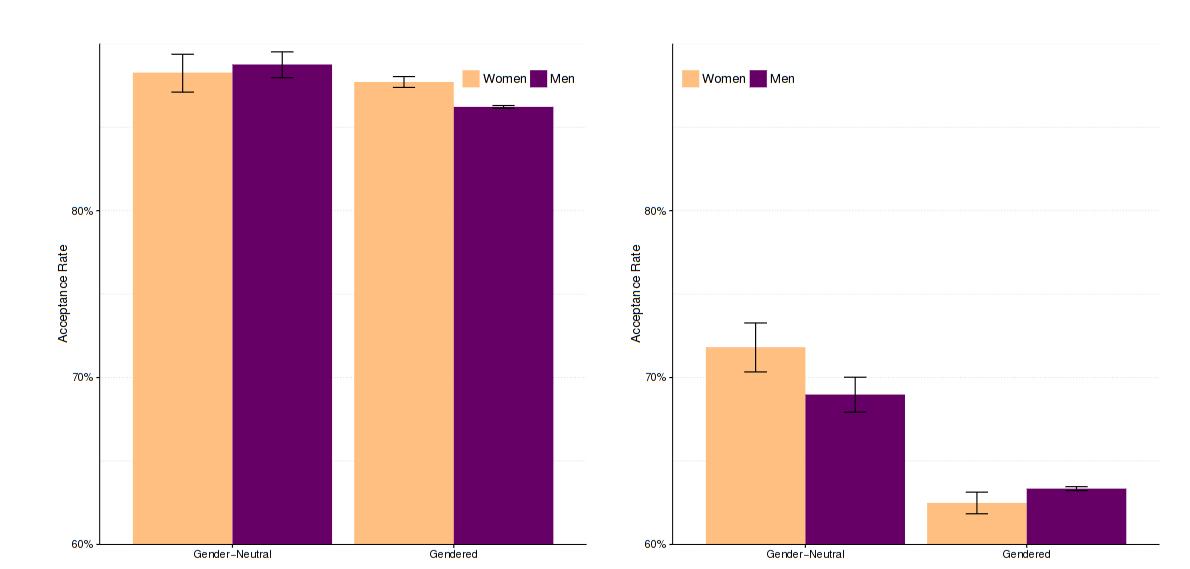Our results show that women’s contributions tend to be accepted more often than men’s [when their gender is hidden]. However, when a woman’s gender is identifiable, they are rejected more often. Our results suggest that although women on GitHub may be more competent overall, bias against them exists nonetheless.
They didn’t use very comprehensive research methods. Also they only used Github.
First, from the GHTorrent data set, we extract the email addresses of GitHub users. Second, for each email address, we use the search engine in the Google+ social network to search for users with that email address. Third, we parse the returned users’ ‘About’ page to scrape their gender.
a bias against men exists, that is, a form of reverse discrimination.
How is it reverse discrimination. It’s still plain old discrimination. I’m starting to smell a biased research here. Or at least the researchers have a bias.
Thanks for pointing it out. There is clearly room for a lot of error.
Thanks for pointing it out. There is clearly room for a lot of error.
Clearly discrimination is only against woman thus reverse discrimination is against man. /s
Anyone found the specific numbers of acceptance rate with in comparison to no knowledge of the gender?
On researchgate I only found the abstract and a chart that doesn’t indicate exactly which numbers are shown.
…or the research is flawed. Gender identity was gained from social media accounts. So maybe it’s a general bias against social media users (half joking).
I think (unless I misunderstood the paper), they only included people who had a Google+ profile with a gender specified in the study at all (this is from 2016 when Google were still trying to make Google+ a thing).
Thanks for grabbing the chart.
My Stats 101 alarm bells go off whenever I see a graph that does not start with 0 on the Y axis. It makes the differences look bigger than they are.
The ‘outsiders, gendered’ which is the headline stat, shows a 1% difference between women and men. When their gender is unknown there is a 3% difference in the other direction (I’m just eyeballing the graph here as they did not provide their underlying data, lol wtf ). So, overall, the sexism effect seems to be about 4%.
That’s a bit crap but does not blow my hair back. I was expecting more, considering what we know about gender pay gaps, etc.
From the post’s link:
We hypothesized that pull requests made by women are less likely to be accepted than those made by men. Prior work on gender bias in hiring – that women tend to have resumes less favorably evaluated than men (5) – suggests that this hypothesis may be true.
To evaluate this hypothesis, we looked at the pull status of every pull request submitted by women compared to those submitted by men. We then calculate the merge rate and corresponding confidence interval, using the Clopper-Pearson exact method (15), and find the following:
Open Closed Merged Merge Rate 95% Confidence Interval Women 8,216 21,890 111,011 78.6% [78.45%, 78.87%] Men 150,248 591,785 2,181,517 74.6% [74.56%, 74.67%] 4 percentage point difference overall.
Pull requests can be made by anyone, including both insiders (explicitly authorized owners and collaborators) and outsiders (other GitHub users). If we exclude insiders from our analysis, the women’s acceptance rate (64.4%) continues to be significantly higher than men’s (62.7%) (χ2(df = 2, n = 2, 473, 190) = 492, p < .001)
Emphasis mine. that’s 1.7 percentage points.
The final paragraph also omits how the acceptance changes after gender is “revealed” (username, profile image). The graph doesn’t help either
For outsiders, we see evidence for gender bias: women’s acceptance rates are 71.8% when they use gender neutral profiles, but drop to 62.5% when their gender is identifiable. There is a similar drop for men, but the effect is not as strong. Women have a higher acceptance rate of pull requests overall (as we reported earlier), but when they’re outsiders and their gender is identifiable, they have a lower acceptance rate than men.
So women drop from 71.8% to 62.5% = 9,3 percentage points, and they say it’s more than men, but don’t reveal the difference. Only graph has an indication (unless I’m missing a table) and it may be 5 (?) percentage points for men. Which would be about 4 percentage points between both genders.

Figure 5: Pull request acceptance rate by gender and perceived gender, with 95% Clopper-Pearson confidence intervals, for insiders (left) and outsiders (right) The conclusion:
Our results suggest that although women on GitHub may be more competent overall, bias against them exists nonetheless.
That’s quite exaggerated for <=5 percentage points. Especially for the number of people involved.
Out of 4,037,953 GitHub user profiles with email addresses, we were able to identify 1,426,121 (35.3%) of them as men or women through their public Google+ profiles.
Maybe I missed it, but how many of those were women and how many made PRs?
in a 2013 survey of the more than 2000 open source developers who indicated a gender, only 11.2% were women
Let’s compare the PR rate per gender:
Let’s say the percentage of women did not increase since 2013, which I’d find difficult to believe, that’s 1,269,247 men and 156,873 women. Men made 150,248 + 591,785 + 2,181,517 = 2,923,550 PRs. Women made 8,216 + 21,890 + 111,011 = 141,117 PRs. That’s ~2.3 PRs per man and ~0,9 PRs per woman. If the percentage changed and more women became contributors, that would decrease the PRs per woman.
That leads me to ask:
- are women more hesitant to contribute PRs that might not be merged? if so, it might contribute to why their PRs are merged more often
- are the women with accounts on github more likely to be people who have some kind of education in the IT field? if there are less hobbyist women (percentage-wise) on github, and more hobbyist men who just chuck their stuff online then decide to contribute to a project, it might contribute to PR acceptance (you’re comparing pros to amateurs)
- what does a similar acceptance rate for double the amount of PRs for men actually say? I don’t know, but it might be pertinent.
I very much encourage humans to contribute to opensource. So, while this paper says something about the current state of things, it doesn’t seem like it’s saying much. The differences in pull request acceptance are not very significant (<5 percentage points) to me
This research isn’t peer reviewed so I wouldn’t take it at face value just yet.
I think the most striking thing is that for outsiders (i.e. non repo members) the acceptance rates for gendered are lower by a large and significant amount compared to non-gendered, regardless of the gender on Google+.
The definition of gendered basically means including the name or photo. In other words, putting your name and/or photo as your GitHub username is significantly correlated with decreased chances of a PR being merged as an outsider.
I suspect this definition of gendered also correlates heavily with other forms of discrimination. For example, name or photo likely also reveals ethnicity or skin colour in many cases. So an alternative hypothesis is that there is racism at play in deciding which PRs people, on average, accept. This would be a significant confounding factor with gender if the gender split of Open Source contributors is different by skin colour or ethnicity (which is plausible if there are different gender roles in different nations, and obviously different percentages of skin colour / ethnicity in different nations).
To really prove this is a gender effect they could do an experiment: assign participants to submit PRs either as a gendered or non-gendered profile, and measure the results. If that is too hard, an alternative for future research might be to at least try harder to compensate for confounding effects.
Here’s the final peer reviewed version https://peerj.com/articles/cs-111/.
Really great comments at https://peerj.com/articles/cs-111/reviews/. The reviewers are very nice about it but do point out some big issues towards the end.
Obligatory mentions of the replication crisis and the Hierarchy of evidence.
Bias against women exists (I remember hearing various “insights” about women IRL from men) but i think something else is going on, reportedly even people who report they are men get “discriminated”, maybe it’s just people who are extroverted show their gender and that slightly correlates with lower quality?
Also i remember reading some woman saying she does not show her gender online to avoid harassment, maybe that also correlates (younger woman not having that insight that not showing your gender could be a net win for the preferences they have)




